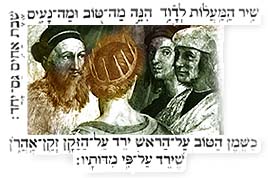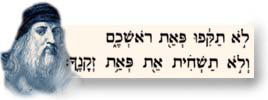|


Egyptian,
Assyrian and Babylonian monuments depict the unique way various
peoples treated facial hair. The Semites appear with either thick
beards or thin, groomed ones; the Libyans have pointed beards;
while the Babylonians and Persians are represented with curly
and groomed beards. Sea Peoples, Hittites, Ethiopians, and most
Egyptians are portrayed as clean-shaven.
In ancient Israel
a long and well-groomed beard was considered a mark of distinction:
"It is like the precious oil upon the head running down upon
the beard, upon the beard of Aaron that went down to the skirts
of his garments."[1]
The Hebrews
avoided shaving the beard and the hair of the head. The nazir,
a type of priest, was forbidden to shave the hair of his head
and the edges of his beard. [2]
Shaving is also a part of ritual purification.[3]
A shaved head and beard was a sign of disgrace,[4]
and one case of humiliation by shaving half a beard is recorded.[5]
Shaving was identified with the spontaneous plucking of the beard,
an expression of great sorrow.[6]
The prohibition against cutting the hair and shaving was later
established as a fundamental mourning practice.
|

You
shall not round the side-growth of your head
nor destroy the side-growth of your beard. …."
(Lev. 19:27)
|
The Torah
forbids cutting the "corners" (sidelocks) of the hair:
"You shall not round the side-growth of your head [pe'at
rosh'hem] on your head, or destroy the side-growth [pe-at
zekaneha] of your beard. You shall not make gashes in your
flesh for the dead,or incise any marks on yourselves…."[7]
Interestingly, the Hebrew word for "side growth" is
pe'ah, the same word used earlier in verse 9 to designate
the corner or edge of a field: "When you reap the harvest
of your land, you shall not reap all the way to the edges of your
field {pe'at sad'ha]. According to the Talmud pe'at
rosh'hem refers to the hair on the temple, from the back of
the ears to the forehead;[8]
depilatory powder, scissors, or an electric shaver, permitted
for shaving the face, may not be used on this area.
While the Torah's
intention seems to be to differentiate Israelites from other peoples,
or to avoid imitating a particular pagan custom, evidence from the
Middle Ages indicates that Jews generally followed the customs of
the countries in which they lived. It appears that trimming the
beard was customary in Christian countries, especially Italy, while
Jews residing in Moslem lands allowed their beards to grow naturally
as was the custom there. Parchon, the 12th century Italian Jewish
grammarian, condemned the Jews of Christian lands who let their
hair grow long. In Italy, Jewish parents cut their boys' hair so
that a curl remained on the top and they would not stand out among
Christian boys.
Israel Abrahams
writes in Jewish Life in the Middle Ages that while the
Jew would not wear the Moslem's "heaven-lock," he was
by no means devoted to the love-lock pendant from his ears, which
became in the Middle Ages a distinctly Jewish feature. In northern
Africa the Jews satisfied themselves by leaving a single hair
to represent the "corner." Shaving was common in Majorca
in the fifteenth century. Later in Leghorna, a takana (rabbinical
injunction) was introduced to enforce the use of scissors or a
depilatory in preference to a razor.
In contemporary
times, ultra-Orthodox men grow their beards long, while modern-Orthodox
men use an electrical shaver, relying on the a widely accepted
pesak-halakha (religious ruling).
|